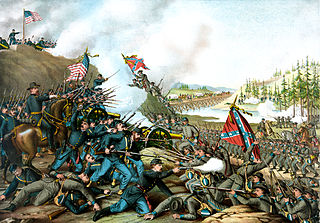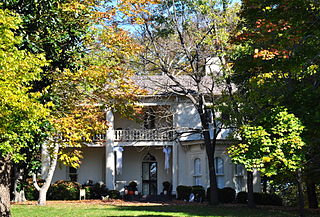
The Battle of Franklin was fought on November 30, 1864, in Franklin, Tennessee, as part of the Franklin–Nashville Campaign of the American Civil War. It was one of the worst disasters of the war for the Confederate States Army. Confederate Lieutenant General (LTG) John Bell Hood's Army of Tennessee conducted numerous frontal assaults against fortified positions occupied by the Union forces under Major General (MGEN) John Schofield and was unable to prevent Schofield from executing a planned, orderly withdrawal to Nashville.
Samuel Cole Williams was an American jurist, historian, educator, and businessman. He was born and raised in the state of Tennessee, where he primarily had his career in Johnson City in East Tennessee.

Robert Benjamin Hicks III was an American author. He wrote the New York Times bestsellerThe Widow of the South and has played a major role in preserving the historic Carnton mansion, a focal point in the Battle of Franklin which occurred on November 30, 1864. Nashville Lifestyles Magazine named Hicks among the top 100 Reasons to Love Nashville, describing him as Nashville's "Master of Ceremonies".

Carnton is a historic plantation home built in 1826 in Franklin, Williamson County, Tennessee, United States. The property, comprising 1,420 acres (5.7 km2), played an important role during and immediately after the Battle of Franklin during the American Civil War. Carnton was situated less than one mile (1.6 km) from the location of the 1864 battle's Union Army eastern flank, and it became the principal temporary field hospital for tending the wounded. More than 1,750 Confederate soldiers lost their lives at Franklin, and on Carnton's back porch four deceased Confederate generals' bodies were laid out for a few hours after the battle. The life of Carrie McGavock, who lived at Carnton during the civil war, was the subject of a best-selling novel in 2005 by Robert Hicks, entitled The Widow of the South. The house was listed on the National Register of Historic Places in 1973, and became a museum managed by The Battle of Franklin Trust, a non-profit organization.

The McGavock Confederate Cemetery is located in Franklin, Tennessee. It was established in June 1866 as a private cemetery on land donated by the McGavock planter family.
The Jenkins' Ferry Battleground State Park, also known as the Jenkins' Ferry Battlefield, is a battlefield in Grant County, Arkansas. The Arkansas state park commemorates the Battle of Jenkins' Ferry fought on Saturday, April 30, 1864, during the Red River Campaign of the American Civil War.
Franklin Battlefield was the site of the Second Battle of Franklin, which occurred late in the American Civil War. It is located in the southern part of Franklin, Tennessee, on U.S. 31. It was declared a National Historic Landmark in 1960.

College Grove is an unincorporated community near Franklin and Murfreesboro in Williamson County, Tennessee. College Grove is predominantly rural.
The Tennessee Historical Commission (THC) is the State Historic Preservation Office for the U.S. state of Tennessee. Headquartered in Nashville, it is an independent state agency, administratively attached to the Department of Environment and Conservation. Its mission is to protect, preserve, interpret, maintain, and administer historic places; to encourage the inclusive diverse study of Tennessee's history for the benefit of future generations; to mark important locations, persons, and events in Tennessee history; to assist in worthy publication projects; to review, comment on and identify projects that will potentially impact historic properties; to locate, identify, record, and nominate to the National Register of Historic Places all properties which meet National Register criteria, and to implement other programs of the National Historic Preservation Act of 1966 as amended. The Tennessee Historical Commission also refers to the entity consisting of 24 Governor-appointed members and five ex officio members.

Sabine Hill, also known as Happy Valley, Watauga Point, and the General Nathaniel Taylor House, is a historic house in Elizabethton, Tennessee. The two-story Federal style building was listed on the National Register of Historic Places in 1973. It is an excellent example of federal architecture. It was threatened by demolition in 2007 when the owners sought to have the property rezoned for apartments. The rezoning request was denied and the home was bought by several preservation-minded locals who secured it until the State of Tennessee/Tennessee Historical Commission could purchase the museum-quality property. It is now restored and opened to the public on November 1, 2017, as a unit of Sycamore Shoals State Park. The property is operated by the Park under a memorandum of understanding with the Tennessee Historical Commission.

The Lotz House is a two-story frame house built in 1858 in the central Tennessee town of Franklin. The house is significant for being in the epicenter of the Battle of Franklin in the American Civil War in 1864.

Fort Granger was a Union fort built in 1862 in Franklin, Tennessee, south of Nashville, after their forces occupied the state during the American Civil War. One of several fortifications constructed in the Franklin Battlefield, the fort was used by Union troops to defend their positions in Middle Tennessee against Confederate attackers. The Second Battle of Franklin in 1864, part of the Franklin-Nashville Campaign in the Western Theater, was the most notable engagement of this area during the Civil War.

The Apheus Truett House is a frame house located at 228 Franklin Road in Franklin, Tennessee, that was listed on the National Register of Historic Places (NRHP) in 1988. Built in 1846, it is a notable example of a two-story vernacular I-house structure in Williamson County. It includes Central passage plan architecture. The NRHP listing is for an area of 5.2 acres (2.1 ha), with one contributing building and two non-contributing structures.

The Owen-Cox House is a property in Brentwood, Tennessee that was listed on the National Register of Historic Places in 1988. The property is also known as Maplelawn.
Roper's Knob Fortifications were constructed by Union Army forces between February and May 1863 in Franklin, Tennessee. According to Tennessee Archaeology, "Roper's Knob served as part of a chain of signal stations that provided a communications link from Franklin to Murfreesboro. Additionally the knob had a large redoubt capable of holding four large artillery pieces, a blockhouse, cisterns, and a magazine. ... "
Winstead Hill is a property in Franklin, Tennessee that has significance in 1864 for being in the Second Battle of Franklin battlefield. It is located within the Franklin Battlefield, a U.S. National Historic Landmark area.

The Harrison House is historic slave plantation home property in Franklin, Tennessee that was listed on the United States National Register of Historic Places (NRHP) in 1975. It was built perhaps in 1810 and was extended and remodelled in 1848 by William Harrison. The remodelling added a "two-story entrance portico and second-story gallery porch typical of many antebellum homes."

Randal McGavock (1766–1843) was an American politician and Southern planter in Nashville, Tennessee. Identifying as a Jeffersonian Republican, he served as the Mayor of Nashville, Tennessee from 1824 to 1825.
The Civil War Trust's Civil War Discovery Trail is a heritage tourism program that links more than 600 U.S. Civil War sites in more than 30 states. The program is one of the White House Millennium Council's sixteen flagship National Millennium Trails. Sites on the trail include battlefields, museums, historic sites, forts and cemeteries.
















